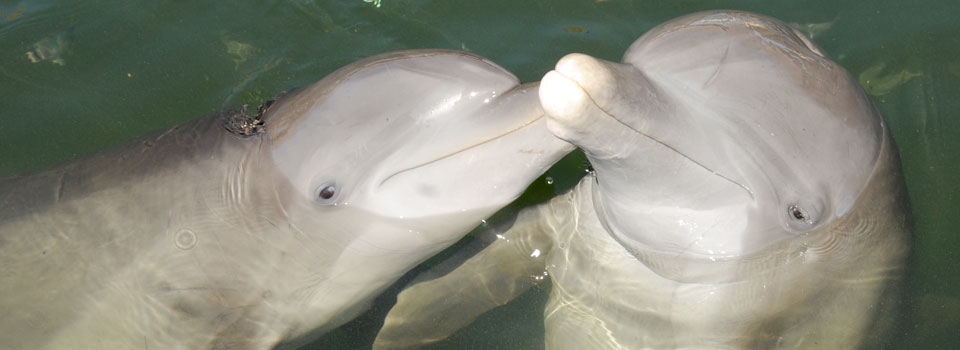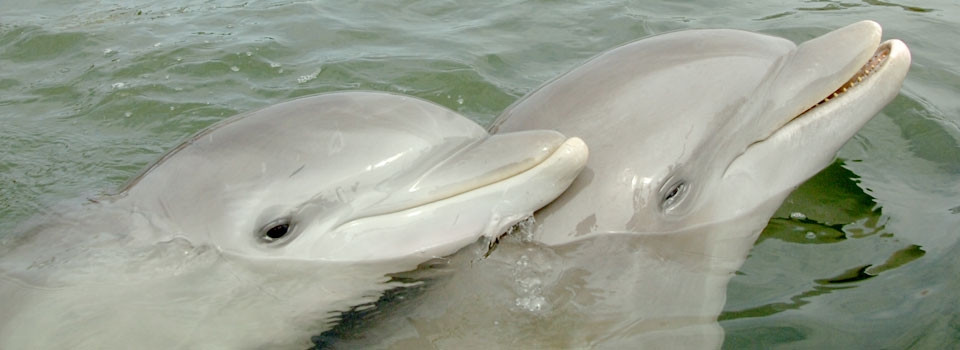Dolphin Communication
Communication in bottlenose dolphins appears to be extensive and complex. A dolphin maintains an intricate social network that includes a few close associates (such as mothers and calves or pair-bonded males), plus more casual relationships with others who come and go within a larger group. Dolphins hunt together to find food. Pods of dolphins coordinate their movements to herd prey, and then take turns swimming into the middle of the assembled fish to eat. There is still much to learn about how dolphins communicate though a number of generalities have emerged from research.
Sound travels 4.5 – 5 times faster through water than through the air. For this reason dolphins rely on sound for communication more than any other mode. Scientists believe that every bottlenose dolphin develops a distinctive high-pitched whistle, called a signature whistle (Tyack, 2000). This whistle appears to serve as a means of individual identification, much like a name. It may let the rest of the pod know which pod members are around, where they are, and, perhaps, something about their mental state. Dolphins in distress sometimes emit their signature whistles very loudly. Whistles may serve to establish or maintain vocal or physical contact between dolphins. Dolphins often respond to another dolphin’s whistle by whistling themselves or moving toward the whistler. If they become separated, a young calf and its mother whistle frequently until reunited. Dolphins also whistle when separated from other group members.
Dolphins do not always respond immediately to another dolphin whistling. Sometimes, many dolphins in the group whistle at once, repeating their signature whistles over and over. In this case, the whistling may help the dolphins keep track of each other.
Bottlenose dolphins also seem to whistle while foraging on various prey items (Acevedo-Guiterrez 2004). Scientists believe that as a group of dolphins finds a school of potential prey they will vocalize more frequently. This increase in vocalizations attracts more dolphins to the area that can assist with rounding up the fish, allowing all individuals to get a larger meal. An increase in the number of dolphins nearby also provides safety for all individuals, as sharks and other large predators are likely to want to feed from the same food source the dolphins have discovered.
Dolphins are capable of imitating certain sounds very accurately and often learn other dolphins' whistles. One reason for imitating another dolphin's whistle may be to get its attention within a large group. Preliminary research seems to support this idea although details of the exact reason for imitation are still under investigation.
Dolphins may use other sounds besides whistles to communicate. Courtship behavior can yield pulsed yelps. When under duress, dolphins emit pulsed squeaks. Aggressive confrontation can produce buzzing click-trains.
Dolphins do not generally rely on visual communication, although they have excellent eyesight both above and below the water’s surface. There is often silt and other particles floating in the water column that can make it difficult for dolphins to communicate visually over long distances. However, when close to each other, body language may play a role in dolphin communication. Researchers are still studying the behaviors and situations when dolphins use body language and there are still many questions regarding the meaning of any specific body movement. Following is a list of dolphin behaviors observed here at Dolphin Research Center. These behaviors are possibly used as a means of visual communication.
Arch: Bend head and tail ventrally.
Eyewhite display: Rolling eyes, showing the whites.
Flex: Bend head and tail dorsally.
Headwag: Rapid, side to side shaking of the head.
Play dead: Roll over submissively in the vicinity of another dolphin.
Snit: Sharp, sideways head jerk with closed or open jaws; may be accompanied by sound.*
*May indicate agitation or aggressive behavior.
To some extent, dolphins may also communicate by touch. Calves swim close to their mothers, brushing their bodies with their flanks and pectoral fins. This may serve to strengthen their bond and promote or strengthen social ties. On the other hand, dolphins use touch in rough, aggressive ways during courtship and when establishing dominance. They use their teeth to make parallel scratches, called rake marks, on each other's skin. Scientists continue to study these behaviors and the situations in which dolphins use them to learn exactly what they might mean. Below is a list of behaviors that we have observed our dolphins using here at Dolphin Research Center, possibly to communicate by touch.
Bite : Close mouth around body part of another animal.*
Butt : Hit with melon or snout.*
Hold hands: Swim with pectoral fins overlapping.
Mouth: Touch another animal with open mouth.
Nuzzle: Touch or rub another animal with closed mouth.
Pectoral Pat: Tap or stroke with pectoral fins.
Push: Forcefully press against another animal with head or rostrum.*
Ram: Hit another animal full force, head-on.*
Rub: Two animals touch body parts, moving against each other with friction.
Stranding on chest: One animal inverted, lifting another out of water, putting recipient between the flippers (often between mother and calf).
Stranding on rostrum: One animal lifting another out of the water, carrying recipient on the rostrum (often between mother and calf).
Tail kick: Strike with tail.*
Tooth rake: Draw teeth across the body of another animal.*
*May indicate agitation or aggressive behavior.
For many years, researchers have looked for evidence of a dolphin language, a way to share complicated information such as stories, family histories, and philosophy in the way that humans do. Although a few dolphins have learned to use a simple artificial language consisting of hand gestures or computer-generated whistles, extensive research to date has failed to demonstrate a natural language in dolphins.
References
Acevedo- Guiterrez, A., and S. C. Steinessen. 2004. Bottlenose dolphins (Tursiops truncatus) increase number of whistles when feeding. Aquatic Mammals 30(3): 357-362.
Brewczak, Nancy L. 1988. Delving Into Dolphin Intelligence.Sky. November.
Brownlee, Shannon 1985. A Riddle Wrapped In A Mystery. Discover. October.
Bryden, M.M. and Peter Corkeron. 1988. Intelligence. Whales, Dolphins and Porpoises. A Facts on File Publication
Chun, N.K.W. 1978. Aerial Visual Shape Discrimination and Matching-to-Sample Problem Solving Ability of an Atlantic Bottlenose Dolphin. Naval Ocean Systems Center, San Diego, CA.
Guttman, Norman and Harry Kalish. 1958. Experiments in Discrimination. Scientific American.
Herman, Louis M. The Visual Dolphin. Seventh Biennial Conference on the Biology of Marine Mammals.
Herman, L., A.A. Pack, and P. Morrel-Samuels. 1993. Representational and Conceptual Skills of Dolphins. In Language and Communication: Comparative Perspectives, H.L. Roitblat, L.M. Herman, and P.E. Nachtigall (eds). Lawrence Erlbaum Associates, Hillsdale, NJ.
Herman, L.M., S.A. Kuczaj II, and M.D. Holder. 1993. Responses to Anamolous Gestural Sequences by a Language-Trained Dolphin: Evidence for Processing of Semantic Relations and Syntactic Information. Journal of Experimental Psychology 122(2): 184-194.
Herman, L.M. and R.U. Uyeyama. 1999. The Dolphin’s Grammatical Competency: Comments on Kako (1999). Animal Learning and Behavior 27(1): 18-23.
Herman, L.M., et. al. 1999. Dolphins (Tursiops truncatus) Comprehend the Referential Character of the Human Pointing Gesture. Journal of Comparative Psychology 113(4): 347- 364.
Linden , E. 1993. Can Animals Think? Time 141(12): 54-61.
Mercado, III, E. S.O. Murray, R.K. Uyeyama, A.A. Pack, and L.M. Herman. 1998. Memory for Recent Actions in the Bottlenosed Dolphin (Tursiops truncatus): Repetition of Arbitrary Behaviors Using an Abstract Rule. Animal Learning and Behavior 26(2): 210-218.
Mercado, III, E., R.K. Uyeyama, A.A. Pack, and L.M. Herman. 1999. Memory for Action Events in the Bottlenosed Dolphin. Animal Cognition 2: 17-25.
Tyack, Peter L., 2000, Dolphins Whistle a Signature Tune, Science, Vol. 289(584), 2000
Wexler, M. 1994. Thinking About Dolphins. National Wildlife 32(3): 5-9.
Wursig, Bernd. 1983. The Question of Dolphin Awareness Approached Through Studies In Nature. Cetus: Vol. 5(1).












